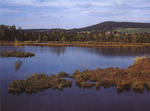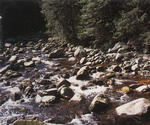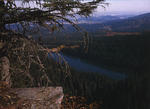
The Sumava with its slopes is an extensive mountain range along the southwestern border of Bohemia. Even if it attains a considerable altitude over a relatively large area, from the Czech side it does not create the impression of high mountain range, since it inclines gradually into the interior, ending in hills in southern and central Bohemia. The Sumava is one of the oldest parts of the Bohemian massif, formations, rising high above the rest of countryside.
The Sumava itself has three major parts, connecting from northwest to southeast. From the Vseruby pass the high peaks of
Kralovsky Hvozd of mica origin rise in sharper contours. This is where the main winter resorts Zelezna Ruda, Spicak, Hojsova Straz etc. are located as well as the popular
lakes of glacial origin, (Black Lake and Devil's Lake) and the region of tourist paths leading to the Pancir, Mustek and Prenet ridge. Kralovsky Hvozd on the southern-eastern side turns into one of the most interesting and characteristic parts of the Sumava - the region of Plane, spreading in the vicinity of Modrava, Kvilda, Borova Lada down to Horni Vltavice.
The Plane are the remains of a former plain, now spreading in an altitude of 1000 - 1100 m above sea level with a few peaks over 1300 m. Towards the southeast are two mountain ranges the so called border range with Trislolicnik and Vitkuv kamen and the inner range with Boubin and Zelnava mountains. Both ranges are covered by forests, Boubin is the oldest Sumava reservation with a virgin forest, founded in 1858.
Between these two ranges lies the geologically very old valley of the upper Vltava river, the so called Vltavice furrow, the lower part of which was flooded by
the Lipno dam. Near the confluence of the river Tepla and Studena Vltava is the well known peat-bog Mrtvy luh (Dead medow). The Lipno dam, 42-44 km long spreads against the stream of Vltava to Zelnava and Nova Pec. Along the left embankment of the lake are many recreational resorts.
The Sumava proceeds, into the interior by high hills (Blansky les and Klet over 1000 m, Svatobor near Susice, etc.) the slopes of

which were in places furrowed by the sharply dropping streams creating valleys along its way, such as the Vydra and Kremelna valleys, the area of which between Antigl and Rejstejn is protected. The whirling water have hollowed some of the rocks in the river forming so called giant pots, which are also found in
the Devil's Rapids of the Vltava river. The slopes of the Sumava around Klatovy and Strakonice is in the nature of an undulating hilly country, with forests on the peaks and fields and meadows between them. Numerous ponds offer good bathing opportunities. Here too are wild-looking valleys, such as Ostruzna valley. Most of the peaks of the Sumava ranges offer beautiful views of the countryside, such as Klet, Javornik, Svatobor.
The region has many relics of the medieval ages, including the town reservations of Domazlice and Prachatice, castles, e.g. Kasperk, Rabi, Helfenburg, the very good preserved late gothic water castle Svihov, etc. A unique monument of Roman architecture is the Romanesque fold at Strakonice. Many remnants of strongholds have been preserved within the farm buildings or castles; an example of such a stronghold is for instance Opalka in the vicinity of the ruins of Klenova castle, Stare Kestrany etc. Among the ecclesiastic structures which have been preserved, the church at Bavorov is quite outstanding and so is the church at Katovice. Domazlice, Klatovy, Vimperk also have interesting historic relics; the valuable illustration of Renaissance art is Kratochvile mansion.



 Guide
Guide 





